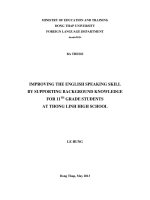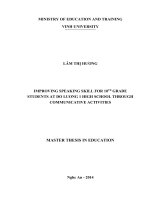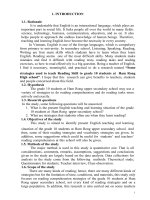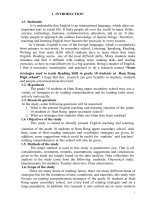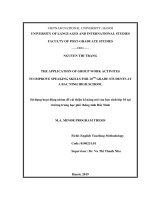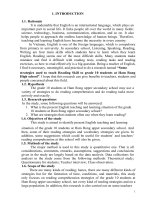Improving speaking skill for 10th grade students at do luong 1 high school through communicative activities master thesis in education
Bạn đang xem bản rút gọn của tài liệu. Xem và tải ngay bản đầy đủ của tài liệu tại đây (468.94 KB, 83 trang )
MINISTRY OF EDUCATION AND TRAINING
VINH UNIVERSITY
LÂM THỊ HƯƠNG
IMPROVING SPEAKING SKILL FOR 10TH GRADE
STUDENTS AT DO LUONG 1 HIGH SCHOOL THROUGH
COMMUNICATIVE ACTIVITIES
MASTER THESIS IN EDUCATION
Nghe An - 2014
MINISTRY OF EDUCATION AND TRAINING
VINH UNIVERSITY
LÂM THỊ HƯƠNG
IMPROVING SPEAKING SKILL FOR 10TH GRADE
STUDENTS AT DO LUONG 1 HIGH SCHOOL THROUGH
COMMUNICATIVE ACTIVITIES
Major: Teaching English to Speakers of Other Languages (TESOL)
Code: 60.140.111
MASTER THESIS IN EDUCATION
SUPERVISOR: TRẦN BÁ TIẾN, Ph.D.
Nghe An – 2014
STATEMENT OF AUTHORSHIP
I hereby acknowledge that this study is mine. The data and findings
discussed in the thesis are true, used with permission from associates, and have not
been published elsewhere.
Author
Lam Thi Huong
AcknowleDgementS
Firstly, I would like to express my sincerest gratitude to my supervisor Dr
Tran Ba Tien who has helped me with his precious knowledge, assistance, and
support during the process of writing.
i
Secondly, I truly wish to thank the teachers at Do Luong 1 High School where
my investigation was carried out for their useful materials, valuable advice and
great cooperation.
In addition, I also like to send my special thanks to all students at Do Luong 1
for their willingness to answer my questionnaires.
Last but not least, my sincere thanks are due to my dear family and my friends
who always stand for me with their consideration and encouragements.
ABSTRACT
This research is concerned about the difficulties encountered in teaching English
and some communicative activities are suggested to improve speaking skill for the
10th grader students at Do Luong 1. Survey questionnaires, interview and class
ii
observation for teachers and students are employed to find the answers to the
questions. From the results of the study, the researcher gets a view on specific
situation of using communicative activities to improve speaking skill for 10th
graders at Do Luong 1 high school. The study has found out some difficulties that
the teachers and students are facing in their speaking lessons. In addition to, the
researcher also suggest some recommendations in applying communicative
activities to develop speaking skill successfully for their 10 th graders. The author
hopes that the study will help teachers to overcome the difficulties in teaching and
learning English speaking skill at Do Luong 1 high school as well as a reference
for those who are interested in this matter.
TABLE OF CONTENTS
INTRODUCTION........................................................................................................
1.1. Rationale................................................................................................................
1.2. Objectives of the study..........................................................................................
iii
1.3. Research questions................................................................................................
1.5. The design of the study..........................................................................................
2.4.1. Aims of communicative activities....................................................................
2.4.4 Roles of communicative activities in language teaching and learning............
2.4.5 Requirements of communicative activities.......................................................
3.2.1 Methods.............................................................................................................
Limitations of the study..............................................................................................
Suggestions for further studies................................................................................................59
LIST OF FIGURES AND TABLES
INTRODUCTION........................................................................................................
1.1. Rationale................................................................................................................
1.2. Objectives of the study..........................................................................................
1.3. Research questions................................................................................................
1.5. The design of the study..........................................................................................
2.4.1. Aims of communicative activities....................................................................
2.4.4 Roles of communicative activities in language teaching and learning............
2.4.5 Requirements of communicative activities.......................................................
3.2.1 Methods.............................................................................................................
Limitations of the study..............................................................................................
iv
Suggestions for further studies................................................................................................59
LIST OF ABBREVIATIONS
CAs: Communicative Activities
CLT: Communicative Language Teaching
v
Chapter 1
INTRODUCTION
1.1. Rationale
English has become an international communicative language in the world. It
has been used widely in many different fields such as economics, politics, culture,
science, technology, education and tourism. It can not be denied that English is one
of the most important means of communication. Therefore, teaching and learning
English is more and more essential.
In Vietnam, English has become a compulsory subject in the syllabus of many
schools, colleges and universities. It has been taught and learned throughout the
country. However, the fact is that the teaching and learning of English has not been
effective yet, especially speaking skill. At Do Luong1 high school, many students
are not interested in speaking lessons as well as they can not speak English well
after leaving school even though they have learnt English for a long time.
Moreover, the teachers of English find it difficult to encourage their students to
speak English naturally in the process of teaching speaking skill.
To meet the demand of learners of English, teachers of English at Do Luong 1
have been trying to find out the most suitable and effective method of teaching
English. They have always tried to catch up with the world’s latest frameworks of
English Language Teaching. As in other schools, teachers of English at Do Luong
1 are now using Communicative Approach to teach English to students. They hope
to provide students with a means of communication, namely English that is vital for
them to be successful in their job and to fulfill their social demands in the time of
globalization.
Therefore, it is really essential to know whether the communicative activities
have the good effects on teaching speaking skill to the 10th graders at Do Luong 1
high school. With the aim to access the method on teaching speaking skill through
the communicative activities, the writer would like to choose the topic “ Improving
1
speaking skill through communicative activities” to find out the answer, and further,
to help improve the teaching of speaking skill at her school.
1.2. Objectives of the study
According to the importance of the participation of the students in speaking
lessons, this study aims at studying on communicative activities in the 10th
graders’ English speaking classes at Do Luong 1 high school.
These are the objectives of the study :
- To investigate the real situation of applying communicative activities in
teaching speaking skill for 10th graders at Do Luong 1 high School, Do Luong
District, Nghe An Province.
- To give some recommendations to improve the students’ speaking skill
through communicative activities
1.3. Research questions
1.3.1. What is the real situation of teaching and learning speaking skill of the 10 th
graders at Do Luong 1 high School, Do Luong District, Nghe An Province ?
1.3.2. How are communicative activities applied in speaking lessons for the
10th graders at Do Luong 1 high school?
1.3.3. What are suggested class communicative activities to improve for the
10th graders’ speaking skill in Do Luong 1 high school?
1.4. Scope of the study
Although there are many different ways to motivate students to learn English,
all these issues can not be fully covered in this paper. Due to the limited time and
the length of a minor thesis, the researcher only focuses on exploiting
communicative activities as a way of improving grade 10th students at Do Luong 1
high school. Besides, the target that the study investigates and serves is just 105
students from 3 classes of grade 10 at this school.
1.5. The design of the study
The study contains five chapters:
2
Chapter 1: Introduction
This chapter presents the rationale, objectives , research questions,
scope and organization of the study.
Chapter 2: Literature review
This chapter introduces a historical overview of the literature. The first is
about CLT method . The next is about speaking skill. The final is about the review
of communicative activities.
Chapter 3: Methodology
To realize the aims of the study, quantitative and qualitative methods have
been used. The data collected for the study came from two sources: the 10 th graders
respondents and the teacher-respondents at Do Luong 1 high school, Nghe An
province.
Two questionnaires, one for students and the other for teachers, and an
interview of teachers was used to collect information and evidence for the study.
All the comments, remarks, recommendations and conclusions provided in the
study are based on the data analysis.
The data takes from the survey questionnaires for students and teachers
is analyzed and categorized. The findings are used as the cornerstone for the
recommendations .
The researcher gave out some communicative activities adapted from the tasks
in Tieng Anh 10 textbook as samples for the secondary teachers to consider.
Additionally, this chapter will present the author’s suggestions on mentioned
problems and summarize all the main points raised in the paper, the limitations of
the study and some suggestions for further studies.
Chapter 4 : Findings and discussions- shows major findings and discussions.
Chapter 5: Implications and recommendations - offers recommendations for
motivating students to speak English through communicative activities.
Conclusion - is a summary of the study in which limitations of the study and
suggestions for further research are presented.
3
Chapter 2
THEORETICAL BACKGROUND
2.1 The nature of language skills
Based on the purpose of analysis and instruction, language is divided into
different skill areas. On the teaching point of view, language skills consist mainly of
four macro-skills: listening, reading, speaking and writing. Those four skills have
supportive relationship. Among the four skills, listening and reading are perceptive
skills while speaking and writing are productive skills (Byrne, 1991, p.8). They are
also divided according to the manners by which they are formed. The skills that are
related to articulate organs are called oral skills that include listening and speaking.
The ones in connection with manual script is named literacy skills that consist of
reading and writing.
Speaking plays an essential role of the four skills. Byrne (1991, p.9) proves
that this oral skill in communication is complementary. If one man is good at
speaking skill, other skills will be much supported.
To sum up, all the above skills are important for learners. Whenever they
acquire those skills they can have confidence in speaking and using a foreign
language. However, it should be emphasized that speaking skill can never be
separated with other skills (listening, reading and writing). All of them are
integrated and supportive to each other.
2.2 Speaking skill
2.2.1 The definitions of speaking skill
Speaking can be seen as the key to human communication. It is a crucial part
of foreign language learning and teaching. There are many definitions of speaking.
Speaking is “the process of building and sharing meaning through the use of verbal
and non-verbal symbols, in a variety contexts” (Chaney, 1998, p.13). Another
definition is proposed by Nunan (1995) which states that speaking is the ability in
using oral language to explore ideas, intentions, thoughts and feelings to other
4
people as a way to make the message clearly delivered and well understood by the
hearer.
Byrne (1991, p.8) describes speaking as “a two-way process between the
speaker(s) and the listener(s) involving the productive skill of speaking and the
receptive skill of understanding.” It can be transferred from his idea that both
speaker and listener have the function in the interaction. The message has to be
encoded by the speaker in order to convey it in appropriate language, while the
listener has to decode the message.
Sharing this point of view Thornbury (2005) reveals that “speaking can be
typified as an activity involving two or more people, in which the participants are
both hearers and speakers having to react to what they hear and make their
contribution.” The communication purpose can be broken when both participants
do not have intention to make their contribution to the conversation.
In short, speaking can be seen as the way people interact and share
information. By mastering speaking skills, students can improve the communicative
competence that helps them much in the process of language acquisition.
2.2.2 The importance of teaching speaking
It is necessary for learners to speak with confidence to carry out many of the
most basic transactions.
Speaking is particularly useful for learning. In language teaching and learning,
this skill is a medium through which much language is learned. According to Kayi
(2006, p.8), communicative abilities in a second language contributes clearly and
efficiently to the success of the learners in school and social environment.
Most of us speak more than we write in our daily lives. According to Wilkin
(1979), speaking when compared with writing is the essential form of language and
writing is ranked second after it and derived from it.
“It is the vehicle of social solidarity, of social ranking, of professional
advancement and of business” (Bygate, 1987, p.7) assumes about the role of
speaking.
5
According to Nunan’s opinions about language learners: “mastering the art of
speaking is the single most important aspect of learning a second language or a
foreign language, and success is measured in term of ability to carry out a
conversation in the language” (Nunan,1991, p.39). It is clear that speaking is a very
important skill among the four basic ones. Therefore, teachers need to motivate
students more often in learning speaking lessons.
2.2.3 Principles for teaching speaking skill
The goal of teaching speaking skills is communicative ability. Therefore, teachers
ought to be concerned about the principles for teaching speaking skill to adapt
appropriate communicative activities.
According to Brown (1994), there are seven principles for teaching speaking skill.
• Principle 1: Focus on both fluency and accuracy depending on your objective.
This principle suggests that teachers should be sure about their tasks that have
linguistic objective and always create opportunities to help students perceive and
use the building blocks of language.
• Principle 2: Provide intrinsically motivating techniques.
According to Brown, teachers have to appeal to students’ ultimate goals and
interests to their need for knowledge, for status, for achieving competence and
autonomy and help them to see how the activity will benefit them.
• Principle 3: Encourage the use of authentic language in meaningful
contexts.
Authentic contexts and meaningful interaction may require teachers a lot
energy and creativity. However, with the help of a storehouse of teacher resource
materials it can be done.
• Principle 4: Provide appropriate feedback and correction.
Teachers have responsibility to make the decision about how to react and
when to react to the students’ performance and inject kinds of corrective feedback
that are appropriate for the moment.
• Principle 5: Capitalize on the natural link between speaking and listening.
6
Speaking and listening are skills which reinforce each other. In other words,
they are closely intertwined. Skills in producing language are often initiated through
comprehension.
• Principle 6: Give students opportunities to initiate oral communication.
Students are given opportunities to show oral communicative competence that
reflects their ability to initiate conversations, to nominate topics, to ask questions, to
control the conversations, and to change the subject.
• Principle 7: Encourage the development of speaking strategy.
This strategy is shown through students’ communicative competence such as
asking for clarification, asking someone to repeat something.
2.2.4 Stages for teaching speaking skill
It is suggested that speaking lesson should have three stages: pre-speaking,
while- speaking, and post-speaking.
The Pre-speaking Stage
This is the stage of the preparations for the students to get familiar to the topic
with some activities such as chatting, games, network, brainstorming, discussion
tasks, vocabulary tasks or pre-speaking questions. Furthermore, this is the step
which teachers motivate students and raise the interest in the lesson. In addition,
before delivering the activities for this stage, the teacher needs to identify the
objective of the lesson, the situation of teaching and learning, and the students’ need
as well.
a. The While-speaking Stage:
This stage is often called controlled speaking. Teachers can design the
activities basing on the tasks in the textbook or adapt some more activities to
increase the communicative factor at this stage. Students are supposed to do the
tasks in pair or group work. This stage aims to develop students’ speaking skill by
doing the controlled tasks and activities themselves. The tasks and activities also
supply opportunity for students to practice the accuracy and fluency. Teacher needs
7
to monitor the activities and provide help for the weak students who have difficulty
completing the task at this stage.
b. The Post-speaking Stage:
This is the freer speaking stage. Students are required to use the target
language that they have learnt and practiced, and their language knowledge to
produce their speaking communicatively. What they produce reflects the result of
their practice stage, their interests or views. At this stage, the teacher plays the role
as observer, assessor who provides appropriate feedback to students.
Basically, a speaking lesson should follow these stages orderly. Nevertheless,
the procedure of a speaking lesson may flexible due to each lesson, time constraint,
objectives of the lesson, types of students and materials in use. However, teacher
needs to have an overview of the lesson to assess how far their students achieve
after the lesson.
2.2.5 Problems with speaking activities
Speaking skill is one of the difficult skills and causes some obstacles and
problems for both the teachers in teaching and the students in learning. Ur (1996)
points out the problems that the students often meet in learning speaking skill as
follows:
• Inhibition: Speaking skill, is different from other skill reading, writing and
listening, focuses on some degree of real time to exposure to an audience. The
learners often have inhibition in trying to say things in a foreign language without
the mother tongue. Moreover, the worries about making mistakes, losing face, or
being simply shy, reserved and timid prevent them from attracting in the speaking
lesson in the classroom.
• Nothing to say: In class, the students are often silent when they are ordered
the speaking activity, because they complain that they can not think of anything to
say, or that they have no motive to express themselves beyond the guilty feeling.
• Lows or uneven participation: The students’ shyness and time limit prevent the
students from the participation of the speaking activities. When working in large
8
groups, one participant can talk at a time and this means that, each one will have only
very little talking time. This problem is compound by the tendency of some learners to
dominate, while others speak very little or not at all.
2.3 Communicative language teaching approach
2.3.1 Concepts of CLT
There are different views about CLT
Richards points out that CLT can be understood as a set of principles about the
goal of language teaching, how learners learn a language, the kind of classroom
activities that best facilitate learning, and the role of teachers and learners in the
classroom.
According to Hymes (1972), he promotes the theory about language as
communication with the target to develop “communicative competence” for
students, which is later considered to be the goal of language teaching, the
backbone of the communicative language teaching approach.
Nunan (1991, p.194) claimed that: “CLT views language as a system for the
expression of meaning. Activities involve oral communication, carrying out
meaning tasks and using language, which is meaningful to the learners. Objectives
reflect the needs of the learners; they include functional skills as well as linguistic
objectives. The learner’s role is as a negotiator and integrator. The teacher’s role is
as a facilitator of the communication process. Materials promote communicative
language use; they are task-based and authentic”.
According to Bock (2000), CLT is tailored to get at meaning and learners
negotiate meaning in class. Meaning is considered as what is communicated. The
negotiation of meaning can be implicated through pair work, group work in
problem-solving tasks. He also states, “Authentic materials, functional tasks, and
group and pair work are significant aspects of CLT”.
In conclusion, above definitions of CLT claim that the goal of teaching
language is to develop learners’ communicative competence that involves the
ability to use the language appropriately to a social context. These components can
9
be seen as linguistic competence, sociolinguistic competence, discourse
competence, and strategic competence.
2.3.2 Characteristics of CLT
According to Brown (2000, p.266), there are four interconnected
characteristics of CLT as follows:
- Classroom goals focus on all of the components of communicative
competence and not restricted to grammatical or linguistic competence.
- Language techniques are designed to engage learners in the pragmatic,
authentic, functional use of language for meaningful purposes. Organizational
language forms are not the central focus but rather aspects of language that enable
the learner to accomplish those purposes.
- Fluency and accuracy are seen as complementary principles underlying
communicative techniques. At times, fluency may have to take on more importance
than accuracy in order to keep learners meaningfully engaged in language use.
- In the communicative classroom, students ultimately have to use the
language productively and receptively, in unrehearsed contexts.
Nunan (1991, p.279) also pointed out five common characteristics of CLT
classrooms:
- An emphasis on learning to communicate through interaction in the target
language.
- The introduction of authentic texts into the learning situation.
- The provision of opportunities for learners to focus, not only on language but
also on the learning process itself.
- An enhancement of the learner’s own personal experiences as important
contributing elements to classroom learning.
- An attempt to link classroom language learning to language activation
outside the classroom.
In general, the above characteristics of communicative approach are very
necessary and important in helping the students to communicate, interact and
10
transfer what they learn in the real context outside the classroom. It is necessary for
the teachers to take notice of all characteristics in order to improve communicative
ability to students.
2.4. Communicative activities
2.4.1. Aims of communicative activities
According to Littlewood (1990) in “Communicative Language Teaching”,
CAs contain these aims:
- Provide ‘whole-task practice’
Through various kinds of communicative activities, learners are provided an
opportunity to train and practise in foreign language learning. In other words, they
practise language in a total skill.
- Improve motivation
The learners’ ultimate objective is to take part in communication with others.
When the activities in the classroom help them achieve this goal, this seems to
motivate them a lot.
-Allow natural learning
There is a fact that many of language learning can take place only through
natural processes, which operate when a person is involved in using the language
for communication. Therefore, communicative activities become an important part
in learning process.
-Create a context that supports learning
Learning language through CAs helps learners establish positive personal
relationship to develop among them and between learners and teacher. In addition,
CAs create an environment which supports individual to show his or her efforts to
learn language.
2.4.2 Characteristics of communicative activities
Communicative activities are designed to encourage the purposeful and
meaningful interaction among students in a language lesson. It is, therefore,
11
important for teachers to be fully aware of their characteristics so that they can use
them effectively.
According to Mulling, Sylvia(1997), activities which are truly communicative
meet almost all of the five following criteria:
The information transfer principle, whereby some information must be
transferred from a sender to a receiver.
The information gap principle, which requires that the receiver does not
already possess the information he or she receives.
The jigsaw principle, whereby students begin with different pieces of
information and finish with the same information.
The task dependency principle, which requires to create whenever students
practise at the levels of controlled and semi-controlled communication before they
are ready to perform the activity at the level of free communication.
The
correction
for
content principle,
which
argues
that during
communication the students’ language production should be judged on its
communicative efficacy in relation to a specific task.
In summary, in order to take the advantage of communicative activities
effectively in the process of teaching and learning, it is necessary for the teachers to
distinguish the characteristics of these two kinds.
2.4.3 Types of oral communicative activities
Different linguists have had different ideas on the distinction of
communicative activities. Littlewood (1990) distinguishes them into two main
categories, which he calls “functional communication activities” and “social
interaction activities”. Harmer (1991) looks at the communicative activities with
oral and written focuses. Therefore, he distinguishes them into “oral communicative
activities” and “written communicative activities”. Harmer's idea seems clearer to
the researcher of this thesis when studying the types of communicative activities.
In this section, we will look at those types of activities with a largely oral
focus (although we should not forget the points about skill integration). Those
12
activities are all designed to provoke spoken communication between students
and/or between the teacher and the students.
+ Communication games
Harmer (1991) has suggested that in communication games activities students
are put into a situation in which they have to use all or any of the language they
possess to complete a game-like task. This type of communicative activities
produces the simplest patterns of interaction. The situation is always that one
student (or group) possesses information which another student (or group) must
discover.
Communication games activities include finding the differences (or
similarities), describe and arrange; story reconstruction and/or poem reconstruction
(Bygate, 1987). In each case of this type of activities, it is the overcoming of the
information gap rather than the production of correct language that signals the
success of the performance. In this respect, the focus of the activity is on “meanings
to be communicated” rather than “linguistic form to be learnt” (Harmer, 1991). The
activities of this type provide the teacher with a convenient bridge between precommunicative and communicative language use, students are engaged in
communicating meaning for a purpose, but they are not made to dispense entirely
with the “structure crutches” provided by the teacher.
+Songs
There are many good rationales for using songs in English classroom. They
are “authentic material”. They enhance student’s sense of achievement in that, for
example, they can sing a song later by themselves. Music creates a relaxing
atmosphere because the whole class sings together. Songs allows maximum
participation by every student in both listening and speaking. Additionally, music
makes a nice change from standard textbook and it is good for developing students’
instincts about intonation and rhythm. Eken (1996, p.46) states that songs can be
used:
• to present a topic, a language point
13
• to practise a language point
• to encourage extensive and intensive listening
• to stimulate discussion of attitudes and feelings
• to encourage creativity and use of imagination
• to provide a relaxed classroom atmosphere
• to bring variety and fun to learning.
In order to choose a suitable song, the teacher should keep in mind that (1)
Songs must be a reasonable length, range, and rhythm. (2) Song should have
repetitive lyrics or chorus that is easy to learn. This allows slower students to
follow. (3) The emotional and conceptual content of a song should be appropriate to
the age and maturity of your students. (4) Songs must be pedagogically appropriate
to the lesson.
As demonstrated, songs are valuable in language teaching and learning. The
teacher is obliged to successfully integrating songs into a language lesson.
+ Discussion
In this type of activity students “have to pool the information in the
discussion” (Littlewood, 1990, p.27). The discussion may be about a proper
problem, for example, “People who throw away rubbish in the forest should get a
fine”. Students have to prepare arguments either in favor of this problem or against
it.
Harmer (1991) has said that many teachers can be heard complaining that their
students have nothing to say or that they have no opinions and are not prepared to
discuss anything. Part of the problem here is the way in which some teachers
approach discussion as an activity. If students are asked to express themselves
fluently on a difficult topic in front of their peers in a foreign language (often with
no warning), they may find themselves reluctant to do so. Therefore, before asking
students to discuss as a whole class, teacher should put them in groups to try out the
topic. This will allow them to give opinion in a less threatening environment than in
14
front of the whole class. It will also give the teacher a chance to see if the topic is
interesting for the students.
Discussion activities are an important part of many lessons. The main thing to
remember is that “proper organization can ensure their success. Lack of it can
provoke their failure” (Harmer, 1991, p.125).
+ Problem solving
Problem solving activities encourage students to talk together to find a
solution to (a set of) problems or tasks. According to Littlewood (1990), this type of
activity dispenses completely with the need to share information. Students now
have access to all the relevant facts. The stimulus for communication comes from
the need to discuss and evaluate these facts, in pairs or groups, in order to solve a
problem or reach a decision. For example, “ What should we do for the future of
our planet?”.
Problem solving activities need not to be based only on everyday situations
that arise inside or outside the classroom. The teacher may also present many
unusual situations in order to stimulate the students’ ingenuity. In these activities,
students must not only analyze information, but also argue, justify and persuade, in
order to reach a common decision. They therefore provide a context for a still wider
range of communicative functions. They also make it still more necessary for
students to develop skills in managing the interaction at the interpersonal level. This
fact often produces a high degree of personal involvement among the participants.
+ Simulation and role - play
According to Harmer (1991), the idea of a simulation is to create the pretence
of a real-life situation in the classroom: students “simulate” the real world. Thus we
might ask them to pretend that they are at an airport, or we might organize them to
get together to plan an imaginary reunion. What we are trying to do artificially of
course is to give students practice in real-world English. Students are asked to adopt
a specific role in this situation. In some cases, they may simply have to act as
themselves. In others, they may have to adopt a· simulated identity.
15
There is some controversy about the usefulness of simulations, particularly
where students are asked to play roles, but many teachers feel that they have certain
advantages because students do not have to take responsibility for their own actions
and words. In other words, it is the character that speaks, not themselves. It has
certainly been noticed that some shy students are more talkative when playing roles.
We will use the term here to denote an activity which involves decisionmaking, in which the participants may act as themselves or in social roles. It is not
performed for an audience, and the participants work together within the constraints
of the imaginary setting.
Simulations do not as a category provides any basis for predicting the kinds of
language skills that learners will use: it depends what kind of simulation is being
considered. For instance, a simulated committee meeting is likely to produce one
kind of interaction, a simulated another interview, and a simulated public meeting a
third. Indeed a single simulation often consists of several different kinds of
interaction, including the three just mentioned. It is, however, possible to make
some predictions, once the nature of the simulation is known.
Simulations general divide into three phases: firstly, a stage for giving the
participants necessary information; secondly, the problem-solving discussion; and
thirdly, follow-up work.
This kind of activity can be carried out during a speaking lesson for example.
After all, they make a report to share their views with the rest of the class.
To enhance the effectiveness of classroom activities, it is worth paying
attention to the matter of grouping students for group work and pair work activities.
In fact, pair work and group work have become the dominant activities in the
class. This is a quite effective way because students can work with different
partners in the class. This makes them more motivated and keeps their interest
during the class time. Thus, teachers should pay attention to more kinds of
activities. These can change the atmosphere of classroom, create authentic
16
situations for students to practise speaking English and help them to develop their
creativity and ability.
After doing this task, students can collect information to talk about the friend
they have interviewed for reporting at the end of the lesson. Most students are eager
to do the task because they can do it in role of the interviewers.
Littlewood (1992, p.49) says: “... simulation and role-play are well-established as
techniques for organizing controlled, pre-communicative language practice, which
prepares students later to take part in fully spontaneous interaction”.
Bygate (1987) states that role-play may be allocated in several ways:
Role-play controlled through cued dialogues.
Role-play controlled through cued situations and goal.
Role-play controlled through cues and information.
Role-play in the form of debate or discussion.
This type of activity could be used for students at different levels of
proficiency in term of complexity of activities. Ladousse (1987, p.7) has shown:
“Role-play is one of communicative techniques which develops fluency in language
students, which promotes interaction in the classroom, and which increases
motivation”.
2.4.4 Roles of communicative activities in language teaching and learning
Communicative activities are considered to be the most useful forms of
foreign language practice in the classroom. Thanks to them, learners are provided
with many opportunities to practice the language they have learnt in a
communicative way. Communicative activities are indispensable in the process of
language teaching and learning for the following roles.
Firstly, communicative activities provide “whole-task practice”: In considering
how people learn to carry out various kinds of skilled performance, it is often useful
to distinguish between (a) training in the part-skills of which the performance is
composed and (b) practice in the total skills, sometimes called “whole-task
practice”. When mentioning the roles of communicative activities, Littlewood
17
(1981) says that “In foreign language learning, our means of providing learners with
whole-task practice in classroom is through various kinds of communicative
activities”. With such advantage, language teachers should design various activities
in order to suit the learners’ level of ability.
Secondly, communicative activities provide motivation. The learner’s ultimate
objective is to participate in communication with others. They will be motivated to
learn if they can see how their classroom learning is related to this objective and
helps them to achieve it with increasing success. In addition, most students’ prior
conception of language is as a means of communication rather than as a structural
system. Their learning is more likely to make sense to them if it can build on this
conception rather than contradict it.
Thirdly, they can provide natural learning. Language learning takes place
inside the learner and it also consists of many aspects that sometimes they are
beyond the teachers’ pedagogical control. It is likely, in fact, that many aspects of
language learning can take place only through natural processes, which operate
when a learner is involved in using the language for communication. As a result,
communicative activities (inside or outside the classroom) are important parts of the
learning process.
Moreover, communicative activities can create a context that supports
learning. They provide opportunities to promote relationship among learners and
between learners and teachers. These relationships are able to “humanize” the
classroom and create a friendly environment that supports the students in their
efforts to learn.
At last, communicative activities such as working in groups, in pairs or
singing etc. create a relatively safe environment for making mistakes along with
relaxed atmosphere, for there is little error correction or distract attention. Students
are not judged and corrected. Moreover, students have a lot of fun when they learn
with communicative activities. This reduces their stress and anxiety about their
performance.
18
